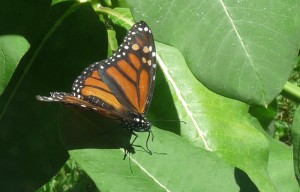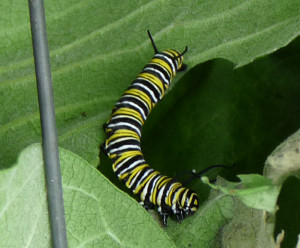(Click on the following link to listen to an audio version of this blog …. Monarchs 2023!
Monarch butterflies (Danaus plexippus) pass over eastern and midwestern North America and up and down our far western coast throughout the spring, summer and early fall seasons. The northward migration of the monarchs jumps along in time with seasonal emergence of milkweed. The monarchs fly from milkweed patch to milkweed patch first as overwintering butterflies from Mexico and then as new, emerging cohorts of adults. No one region ever had enough milkweed to sustain the caterpillars of this huge population of these near-tropical butterflies. They had to follow the availability of their nursery plants from central Mexico all the way into southern Canada.
Maps show the steadily expanding Spring and Summer line of movement of the monarchs: In March the flocks are in the southern-most parts of the country, between Texas and Florida. By April, they have traveled north to a line roughly between Oklahoma and South Carolina, and, then, by May they have moved up past a line between Kansas and Maryland. By early June they reach a line that stretches from Iowa to Ohio, and by late June they finally get to Pennsylvania, New York, New England and southern Canada.
The monarchs are reproducing all along the way (so both nectar producing plants (to provide food for the adult butterflies) and milkweed (to provide food and habitat for the developing caterpillars) are critical at each location!). The loss of these “weed-stops” due to agriculture and herbicide use is one of the main reasons that monarch butterflies are currently in such a precipitous state of decline! The monarchs fly north with the historical expectation of encountering an abundance of milkweed and nectar-rich weeds, but, in recent years, are more likely to encounter herbicide-treated, weed-free corn and soybean fields!
At every stop along the migration chain, each mated female lays between three to four hundred eggs on the milkweed before they die. They spread their eggs out over a large number of plants. The eggs hatch in three to five days depending on the temperature, and the emerging larvae (the “caterpillars”) feed first on their egg capsules and then begin to eat the milkweed leaves. They molt five times during their larval life stage and increase their body mass more than two thousand times. The caterpillars take between 9 and 14 days to go through their five instar growth phases.
The duration of this development at each stop on the migration chain has been historically sufficient to allow the next, more immediately northernly located patch of nectar producing plants and milkweed sufficient time to grow, develop and flower so that the migrating monarchs always encounter plants that are optimally ready to satisfy their needs! A number of climate change models have shown, though, that this precise coordination of plant development and monarch migration rate is breaking down! So, along with human impacts on weed abundance, alteration of climate/plant patterns is also playing a role in the decline of North America monarchs!
The monarch eggs and the larvae growing in the milkweed patches are under intense predation and parasite pressures. More than ninety percent of the eggs and caterpillars fail to survive. Eggs are eaten by ants, earwigs and snails, and larvae are eaten by beetles and other insects (like paper wasps) or killed by parasitoid wasps, bacteria, or fungi. Since the larvae feed exclusively on milkweed leaves they accumulate in their body tissues the milkweed’s cardenolides (a cardiac glycoside that can cause the heart of a vertebrate to stop its contractions!). These cardenolides make the larvae (and, eventually, the adults) poisonous to most vertebrates.
The end stage caterpillar then forms a chrysalis within which the tissues and organs of the larvae dissolve and are reformed into the structures of the butterfly. This metamorphosis takes between nine and fifteen days. The adult butterfly then emerges, mates, and continues on its migration journey.
So at each location, the caterpillars are seen a week or so behind the initial appearance of the arriving adults, and the adults from these caterpillars who then push on northward emerge from their chrysalises about a month later. By the middle of August, after six months of steady migration and reproduction, monarch adults have reached the northern edges of their North American range. They have gone through anywhere from three to six mating/development cycles and have made legions of caterpillars all across the continent. It is then time to turn back toward home!
These late summer/early fall born monarchs are sometimes referred to as the “super-generation.” These butterflies make up the overwintering cohort of monarchs that find their way back down their spring/summer migration pathway all the way to the coniferous forests in the mountains of the Mexican states of Michoacán and Mexico. These overwintering monarchs live 8 or 9 months (compared to 2 to 5 week life span of the “summer” monarchs). These monarchs will be the individuals that then push back north into Texas next February and March where they will mate and lay eggs and start the migration cycle all over again!
The overwintering population of monarchs in these Mexican forests is measured in terms of the area containing trees covered with roosting monarchs. In 1996, over 18 hectares (a hectare is about 2.5 acres) of forest contained trees with overwintering monarchs. Last winter (2022/2023), though, only 2.21 hectares of forest had overwintering monarchs.
From year to year we have had both good news and bad news about the numbers of monarchs overwintering in Mexico or being counted at sites along their migration pathways. Drought in Texas, in particular can have devastating impacts on nectar producing weeds and milkweed populations and can abruptly short-circuit the monarch migration. These year to year fluctuations, though, sometimes obscure the main story about the monarchs: in the past 30 years North American monarch populations have declined by 85 to 95%! Since 2010 (the year when most corn and soybeans grown in the United States became herbicide-resistant varieties (and herbicides were then used very widely to “clean out” all of the field weeds in these agricultural systems)), the monarch overwintering forest areas have fluctuated between 2 or 3 hectares. The species is teetering on the edge of extinction!
The western population of monarchs are separated from the eastern monarchs by the Rocky Mountains. The western monarchs overwinter in the coastal forests of California rather that the mountain forests of Mexico, and as I reported a couple of years ago (Signs of Spring 1, March 7, 2019) only 28,000 western monarch butterflies were counted in their 2018-2019 overwintering sites. This represents an 86% decline from the 2017/2018 count and a 99.4% decline from the 4.5 million monarchs that overwintered on the California coast back in the 1980’s. In 2019-2020 the western winter count was 30,000 butterflies, but in 2020-2021 the overwintering population crashed to just 2,000 butterflies! Many thought that this was the end of the western monarch!
In 2021-2022, though, 250,000 monarchs were counted in their California overwintering sites, and in 2022-2023, 335,479 overwintering monarchs were counted. There is hope that extensive work by groups and by individuals to save and restore appropriate habitats may have averted the immediate extinction of the western monarch.
Western monarchs used to occupy a summer range that extended from the southern California forests all the way up to British Columbia. This northern distribution, though, has greatly declined: now the western monarch does not even get up into Washington State. Researchers are trying to better document the seasonal movements of these western monarchs to try to develop a plan to save their critical habitats and assist their survival. The western population of monarchs, though, could, according to some experts, be extinct in less than twenty years!
So, plant some milkweed! Don’t use herbicides or pesticides! Grow native plants so that their nectars can sustain monarchs and all of the other vital insects of our ecosystems! Everyone, please, be of use!








